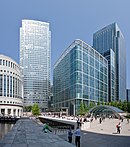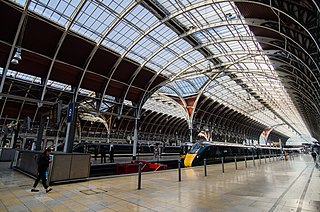
Paddington, also known as London Paddington, is a London railway station and London Underground station complex, located on Praed Street in the Paddington area. The site has been the London terminus of services provided by the Great Western Railway and its successors since 1838. Much of the main line station dates from 1854 and was designed by Isambard Kingdom Brunel. As of the 2022–23 Office of Rail & Road Statistics, it is the second busiest station in the United Kingdom, after London Liverpool Street, with 59.2 million entries and exits.
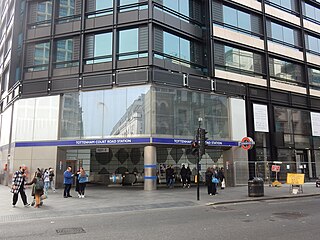
Tottenham Court Road is a London Underground and Elizabeth line station in St Giles in the West End of London. The London Underground station is served by the Central line and the Charing Cross branch of the Northern line. The station is located at St Giles Circus, the junction of Tottenham Court Road, Oxford Street, New Oxford Street and Charing Cross Road and is in Travelcard Zone 1, with a second entrance at Dean Street.

Canary Wharf is an area of London, England, located near the Isle of Dogs in the London Borough of Tower Hamlets. Canary Wharf is defined by the Greater London Authority as being part of London's central business district, alongside Central London. Alongside the City of London, it constitutes one of the main financial centres in the United Kingdom and the world, containing many high-rise buildings including the third-tallest in the UK, One Canada Square, which opened on 26 August 1991.

Crossrail is a completed railway project centred around London. It provides a high-frequency hybrid commuter rail and rapid transit system, known as the Elizabeth line, that crosses the capital from suburbs on the west to east and connects two major railway lines terminating in London: the Great Western Main Line and the Great Eastern Main Line. The project was approved in 2007, and construction began in 2009 on the central section and connections to existing lines that became part of the route, which has been named the Elizabeth line in honour of Queen Elizabeth II who opened the line on 17 May 2022 during her Platinum Jubilee. The central section of the line between Paddington and Abbey Wood opened on 24 May 2022, with 12 trains per hour running in each direction through the core section in Central London.
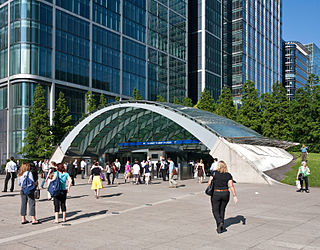
Canary Wharf is a London Underground station at Canary Wharf and is on the Jubilee line, between Canada Water and North Greenwich stations. The station is located in Travelcard Zone 2 and was opened on 17 September 1999 as part of the Jubilee Line Extension. Over 40 million people pass through the station each year, making it second busiest on the London Underground outside Central London after Stratford, and also the busiest that serves only a single line.

West Ealing railway station is on the Great Western Main Line in Ealing, situated in west London. It is 6 miles 46 chains (10.6 km) down the line from London Paddington and is situated between Ealing Broadway to the east and Hanwell to the west. Its three-letter station code is WEA.

Ealing Broadway is a major single-level interchange station located in Ealing, in the London Borough of Ealing, West London for London Underground services and also Elizabeth line services on the National Rail Great Western Main Line.

Farringdon is an interchange station located in Clerkenwell, London, England, in the London Borough of Islington, just outside the boundary of the City of London for London Underground, Elizabeth line and National Rail services.

Custom House is an interchange station by the Royal Docks, in Custom House in the London Borough of Newham, London for Docklands Light Railway (DLR) – on which it is branded Custom House for ExCeL – and Elizabeth line services. It is situated in Travelcard Zone 3.

Southall is a railway station on the Great Western Main Line in Southall, London, England. It is in Travelcard Zone 4 and passenger services are provided by the Elizabeth line from London Paddington. It is 9 miles 6 chains (14.6 km) down the line from Paddington and is situated between Hanwell to the east and Hayes & Harlington to the west.

Dartford railway station serves the town of Dartford in Kent, England. It is 17 miles 12 chains (27.6 km) down the line from London Charing Cross. Train services from the station are operated by Southeastern and Thameslink. Southeastern also manages the station. Dartford is a major interchange station in the North Kent region of the Southeastern network. Ticket barriers control access to the platforms.

Abbey Wood is a National Rail station in Abbey Wood in southeast London, England. It is between Plumstead and Belvedere stations on the North Kent Line. It is 11 miles 43 chains (18.6 km) measured from London Charing Cross, with services to central London routed via Greenwich or Lewisham, and Elizabeth line services to Paddington and Reading via Canary Wharf and Liverpool Street. The station is managed by Transport for London with passenger services provided by Southeastern, Thameslink and the Elizabeth line. It is the closest railway station to the suburb of Thamesmead, which is connected to the station by local buses. The station platforms are located in the Royal Borough of Greenwich with the station entrance in the London Borough of Bexley.

Poplar is a Docklands Light Railway (DLR) station in Poplar in London, England. Poplar is a cross-platform interchange station for three of the six lines on the DLR making it one of the busiest stations on the network in terms of services. It is also nearby the Canary Wharf Station on Crossrail's Elizabeth Line.

South Quay is a Docklands Light Railway (DLR) station on the Isle of Dogs, East London, England. The station is between Crossharbour and Heron Quays stations and is in Travelcard Zone 2. South Quay is in Millwall and is located on the southern shore of the South Dock of the West India Docks; the current station platforms sit astride the channel connecting Millwall Dock to the West India Docks.

West India Quay is a Docklands Light Railway (DLR) station in Canary Wharf’s West India Quay. It is located at the point where the line from Lewisham splits into branches to Tower Gateway/Bank and Stratford. The next stations on each line are Canary Wharf DLR station, Westferry and Poplar DLR station. The station is in Travelcard Zone 2.
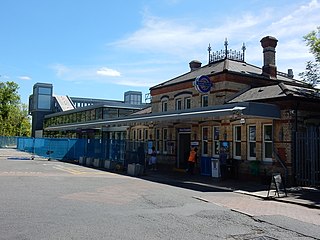
West Drayton railway station serves West Drayton and Yiewsley, western suburbs of London. It is served and managed by the Elizabeth line. It is 13 miles 71 chains (22.3 km) down the line from London Paddington and is situated between Hayes & Harlington to the east and Iver to the west.

Heathrow Terminals 2 & 3 railway station serves Terminal 2 and Terminal 3 at London Heathrow Airport.
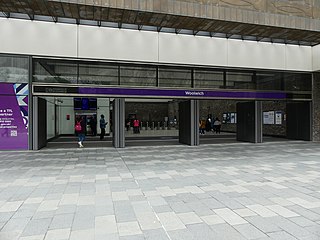
Woolwich railway station is an Elizabeth line station in Woolwich in London, England which opened on 24 May 2022, and has up to 12 trains per hour to Canary Wharf and Central London.

The Elizabeth line is a high-frequency hybrid urban–suburban rail service in London and its suburbs. It runs services on dedicated infrastructure in central London from the Great Western Main Line west of Paddington station to Abbey Wood and via Whitechapel to the Great Eastern Main Line near Stratford; along the Great Western Main Line to Reading and Heathrow Airport in the west; and along the Great Eastern Main Line to Shenfield in the east. The service is named after Queen Elizabeth II, who officially opened the line on 17 May 2022 during her Platinum Jubilee year; passenger services started on 24 May 2022. Despite being named under the same system as London Underground lines, and having sections which are underground, the Elizabeth line is not classified as a London Underground line.
The Crossrail line was first proposed in 1941. It was first proposed to Parliament in 1991 but was rejected. It was then proposed by the government as the Crossrail bill in 2005. Construction started in 2009 and, heavily delayed, the central section was opened by Elizabeth II on 24 May 2022 with full completion due in 2023.

























